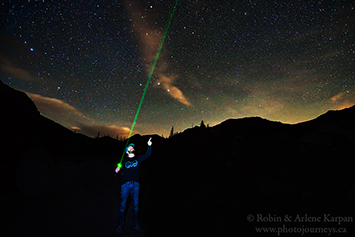

We’re walking in pitch-black dark at 11:00 at night, following the hiking trail to Blakiston Falls in Waterton Lakes National Park. Leading us is Keith Robinson, owner and guide of Dark Sky Guides, who wants to take us as far away from any light pollution as possible. The excursion started when Keith picked us up at 10:30 in the park’s fairly small townsite and drove to the end of the road on the Red Rock Parkway.

First International Dark Sky Park
Tucked into the southwest corner of Alberta, Waterton is designated an International Dark Sky Park, along with its sister park, Glacier National Park, just across the border in Montana. It is the first transnational park in the world to receive that title. A dark sky designation means that the location is relatively free from major sources of light pollution, and that it has committed to take steps to minimize light that is already there. For example, the townsite is redesigning street lights to shine down rather than shine up and around to interfere with our view of the sky. It may sound straightforward, but places like this are becoming increasingly rare around the world.
Keith and his three brothers, all born and raised in Waterton, decided to capitalize on the designation by setting up guided tours to help visitors learn about and appreciate all that the night sky has to offer. Their trips vary from walks around town to do some star gazing to more adventurous excursions like the one we are on now.
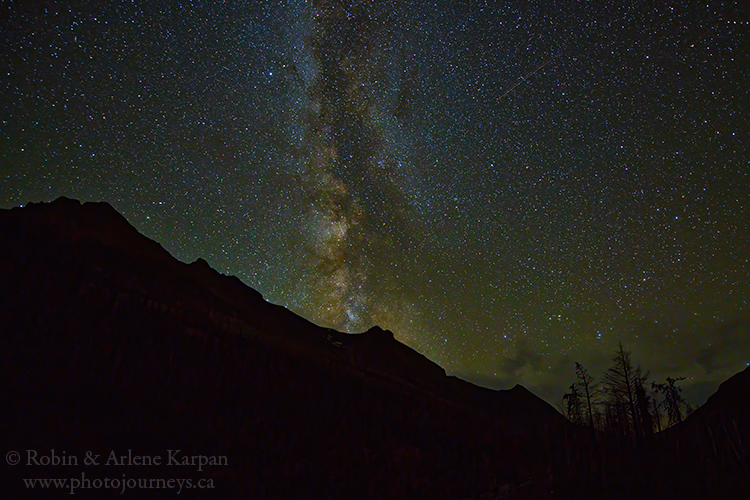
Learning What’s Above
We arrive at the viewing platform overlooking Blakiston Falls, and as we settle into the benches Keith asks us to turn our headlamps off. It’s totally dark, so the millions of stars overhead shine with an unbelievable intensity. Due to a happy coincidence rather than good planning, we’re there during the Perseid Metor Shower, and are treated to brilliant streaks of light zapping across the sky.
Keith talks about the stars, planets, and constellations – what we can see, what they mean, and the stories behind them. The only light was when Keith occasionally used his special laser pointer that was powerful enough to pick out stars. The stories that most of us have heard about the naming of constellations come to us from the ancient world, and often include Greek gods and such. Few of us, however, are familiar with the legends and fables of the sky that come from closer to home. To rectify this, Keith also related a few of the local Blackfoot legends, such as how the Big Dipper came to be. It seems that fascination with the night sky is a universal phenomenon throughout the world.
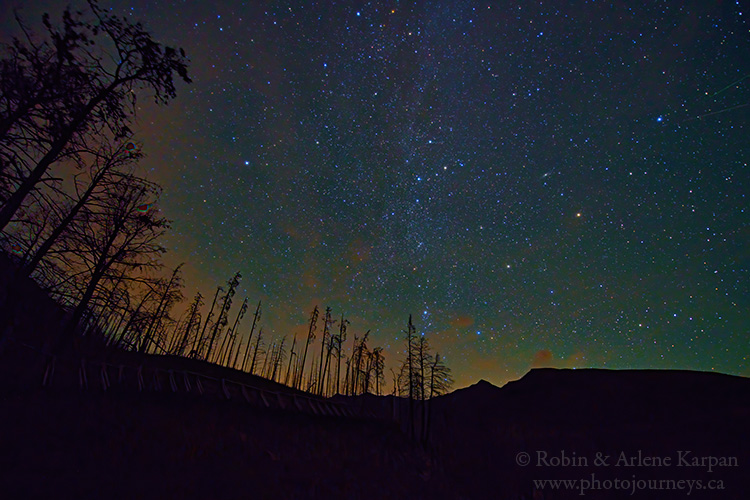
That was the purpose of the trip – to be fascinated with the night sky, to not simply look up and see some stars but to really appreciate what we’re looking at. Besides the tours, The Robinson brothers have more plans in the works, including a new state-of-the-art planetarium soon to be opened on the edge of the park.
While the tour was about night sky appreciation rather than photography, we found that it was also a great opportunity to get some night shots, especially when we were sitting on the platform in total darkness. On other nights during our visit we looked for other nightscape possibilities, not only where it was totally dark, but also where some ambient light added to the photographic possibilities.
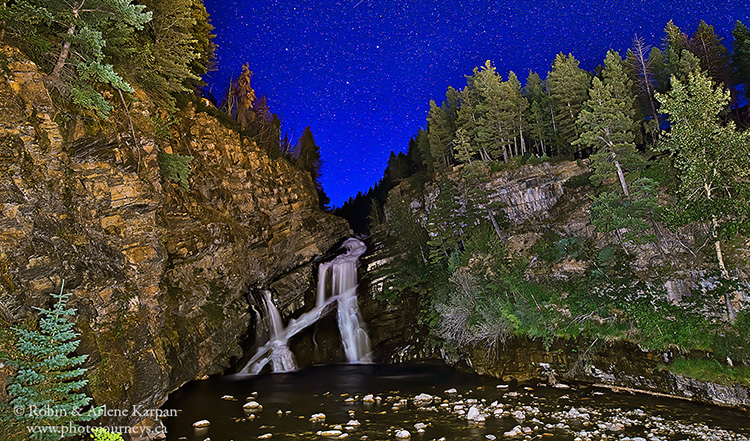
Cameron Falls and Driftwood Beach
Cameron Falls is right in the Waterton townsite. The falls themselves are in darkness, though the cliffs on either side are partially lit from a nearby street lamp. To balance things out, we used a flashlight to do some light painting on the falls. The 15 sec. exposure gave the falls a smooth, silky look.
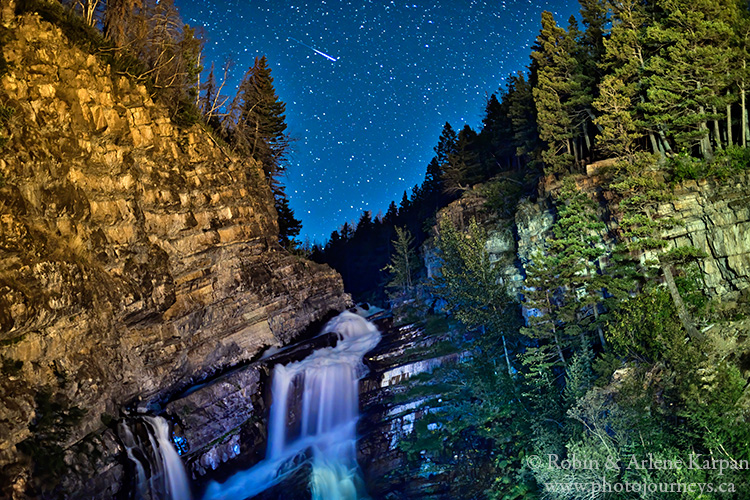
Another spot we liked was so-called Driftwood Beach on the main highway just outside the townsite. A lot of driftwood has accumulated here, and visitors with time on their hands pile them up into semi-structures.
The view across Lower Waterton Lake was dark enough to clearly see the sky. However, the Prince of Wales Hotel, Waterton’s iconic historic hotel, is clearly visible on a prominent hill and a major source of light. We found that the shaft of light across the water was a feature that could be useful in photography. The name of the game in night photography is to play around and try different things. Just as in our star gazing tour, it’s a matter of not simply looking at the stars but appreciating what we’re seeing.
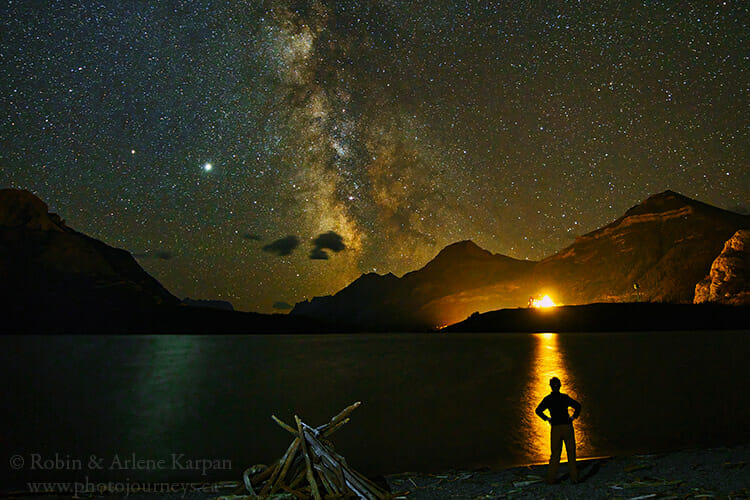
For other things to do, check out our posting The Best of Waterton Lakes National Park See Dark Sky Guides for more information on tours and updates on the planetarium.
For more details on what to do, where to stay, where to eat and other details, check out the Waterton Lakes National Park website. Also see the Parks Canada site for park specific information.
SUBSCRIBE to Photojourneys below
Feel free to PIN this article on Waterton Lakes Night Sky Adventures
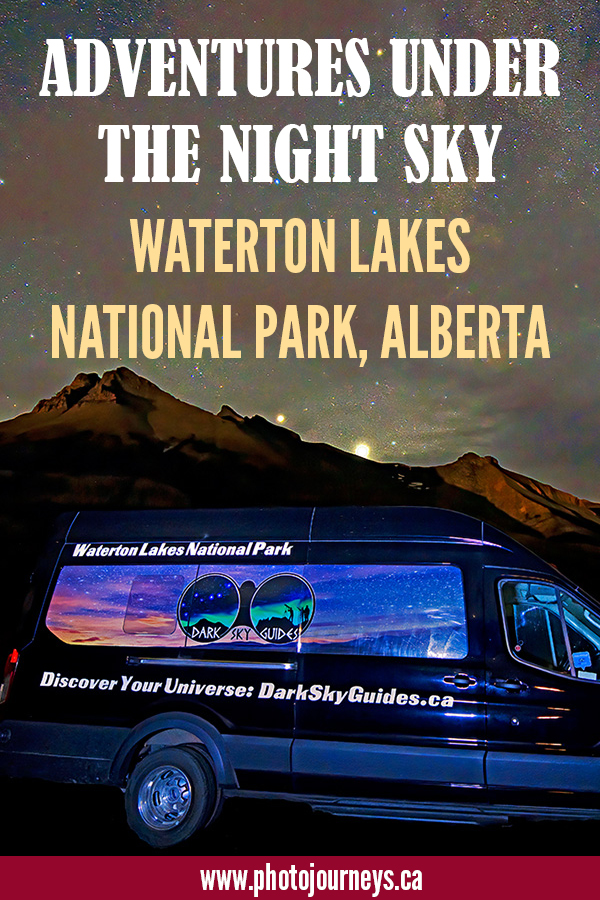


It is unlikely that at my age I will ever get to see this beautiful night sky, is there a web site, or other media platforms where I can enjoy your photos. I just watched National Parks of Canada from Watertown Lakes?
Thanks for your comment. We post most of our photos on this website, Photojourneys.ca, and sometimes on our Instagram account – karpanphotojourneys. Here’s another article that deals with photography and the night sky. https://photojourneys.ca/2024/12/four-easy-ways-to-launch-into-night-photography/